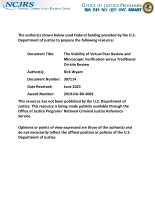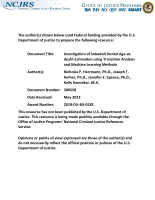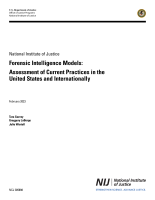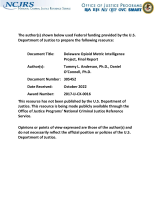Best practices
Evaluating Processes and Outcomes of Housing Models for Victims of Human Trafficking
We Met Them Where They Are, But Is It Enough? A Qualitative Examination Of A Co-Response Outreach Program Servicing Vulnerable Populations in Philadelphia
Domestic Terrorism Targeting America’s Political Elites
De-escalation Training: What Works, Implementation Lessons, and Taking It to Scale; Plenary at the 2023 NIJ Research Conference
Police use of force, while infrequently used, is a tremendous concern to public safety in the United States when officers employ it excessively or inappropriately, causing injury or death and eroding public trust in law enforcement. This plenary from the 2023 NIJ Research Conference describes the Integrating, Communications, Assessment, and Tactics (ICAT) de-escalation training program developed by the Police Executive Research Forum to guide officers in defusing critical incidents.
See the YouTube Terms of Service and Google Privacy Policy
Can Science Enhance Equity? Findings and Implications From a Study To Detect Bruising on Victims with Dark Skin Pigmentation
This plenary panel from the 2023 NIJ Research Conference features fascinating research on a methodology to improve the detection and documentation of bruises on victims of violence who have dark skin pigmentation. This study highlights the intersection between science, justice, and racial equity, featuring practitioner and victims’ advocacy perspectives. The discussion describes the research and its findings and explore strategies to ensure that this particular evidence-based methodology can be widely implemented by nurse practitioners in the field.
Participants:
See the YouTube Terms of Service and Google Privacy Policy
Data Science Approaches in Criminal Justice and Public Health Research: Lessons Learned From Opioid Projects
Collecting and Analyzing DNA Evidence from Fingernails: A Comparative Study
The Viability of Virtual Peer Review and Microscopic Verification versus Traditional On-site Review
Double-Blind Field Evaluation of the MOLE Programmable Detection System
Driving Down Gun Violence (Part Two)
Three LEADS Scholars serving in different law enforcement agencies and positions discuss their experiences with identifying and implementing evidence-based interventions to reduce gun violence. NIJ Senior Advisor Dr. Tamara Herold hosts this conversation with guests Police Chief Cecilia Ashe (Milford Delaware Police Department), Chief of Staff Lieutenant Matthew Barter (Manchester, NH Police Department), and Analytical Services Manager Mr. Jason Schiess (Durham, NC Police Department).
Investigation of Subadult Dental Age-at-death Estimation using Transition Analysis and Machine Learning Methods
Cryptocurrency and Blockchain Needs for Law Enforcement
Juvenile Recidivism: An Examination of State Measurement Strategies
Just Science Podcast: Just DNA Evidence in Sexual Assault Cases
'What to do with the cutters?'–Best practices for offender self-injurious behaviors
Systematic Social Event Modeling: A Methodology for Analyzing Body-worn Camera Footage
Just Science Podcast: Just Managing Mass Fatality Incidents
Forensic Intelligence Models: Assessment of Current Practices in the United States and Internationally
Currently Applied Naming Conventions for Various Subclassifications of Novel Psychoactive Substances
Data Exchange Practices of Medicolegal Death Investigation
Campus Sexual Assault Responses (CSAR): Informing Trauma-Informed Policies, Protocols, and Training
Sexual violence is a significant criminal justice problem with long-term effects for its victims. In particular, sexual assault on or related to college campuses across the United States presents a growing public health and economic burden, starting with significant impacts on academic outcomes.
See the YouTube Terms of Service and Google Privacy Policy
The Safe Communities Safe Schools Model: An Assessment of Model Implementation and Outcomes
The Safe Schools Safe Communities violence prevention framework helps promote school readiness to implement evidence-based practices, but evidence of its effectiveness remains to be seen.








